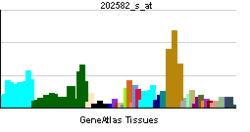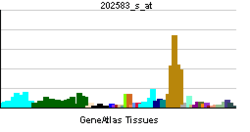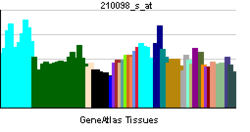RANBP9
| RAN binding protein 9 | |||||||||||||
|---|---|---|---|---|---|---|---|---|---|---|---|---|---|
| Identifiers | |||||||||||||
| Symbols | RANBP9 ; BPM-L; BPM90; RANBPM; RanBP7 | ||||||||||||
| External IDs | OMIM: 603854 MGI: 1928741 HomoloGene: 38057 GeneCards: RANBP9 Gene | ||||||||||||
| |||||||||||||
| RNA expression pattern | |||||||||||||
 | |||||||||||||
 | |||||||||||||
 | |||||||||||||
| More reference expression data | |||||||||||||
| Orthologs | |||||||||||||
| Species | Human | Mouse | |||||||||||
| Entrez | 10048 | 56705 | |||||||||||
| Ensembl | ENSG00000010017 | ENSMUSG00000038546 | |||||||||||
| UniProt | Q96S59 | P69566 | |||||||||||
| RefSeq (mRNA) | NM_005493 | NM_019930 | |||||||||||
| RefSeq (protein) | NP_005484 | NP_064314 | |||||||||||
| Location (UCSC) | Chr 6: 13.62 – 13.71 Mb | Chr 13: 43.4 – 43.48 Mb | |||||||||||
| PubMed search | |||||||||||||
Ran-binding protein 9 is a protein that in humans is encoded by the RANBP9 gene.[1][2]
Function
This gene encodes a protein that binds RAN, a small GTP binding protein belonging to the RAS superfamily that is essential for the translocation of RNA and proteins through the nuclear pore complex. The protein encoded by this gene has also been shown to interact with several other proteins, including met proto-oncogene, homeodomain interacting protein kinase 2, androgen receptor, and cyclin-dependent kinase 11.[2]
Interactions
RANBP9 has been shown to interact with:
References
- ↑ Nakamura M, Masuda H, Horii J, Kuma K, Yokoyama N, Ohba T et al. (Dec 1998). "When Overexpressed, a Novel Centrosomal Protein, RanBPM, Causes Ectopic Microtubule Nucleation Similar to γ-Tubulin". J Cell Biol 143 (4): 1041–52. doi:10.1083/jcb.143.4.1041. PMC 2132962. PMID 9817760.
- ↑ 2.0 2.1 "Entrez Gene: RANBP9 RAN binding protein 9".
- ↑ 3.0 3.1 Rao MA, Cheng H, Quayle AN, Nishitani H, Nelson CC, Rennie PS (Dec 2002). "RanBPM, a nuclear protein that interacts with and regulates transcriptional activity of androgen receptor and glucocorticoid receptor". J. Biol. Chem. 277 (50): 48020–7. doi:10.1074/jbc.M209741200. PMID 12361945.
- ↑ Wang D, Li Z, Messing EM, Wu G (Sep 2002). "Activation of Ras/Erk pathway by a novel MET-interacting protein RanBPM". J. Biol. Chem. 277 (39): 36216–22. doi:10.1074/jbc.M205111200. PMID 12147692.
- ↑ Morris JA, Kandpal G, Ma L, Austin CP (Jul 2003). "DISC1 (Disrupted-In-Schizophrenia 1) is a centrosome-associated protein that interacts with MAP1A, MIPT3, ATF4/5 and NUDEL: regulation and loss of interaction with mutation". Hum. Mol. Genet. 12 (13): 1591–608. doi:10.1093/hmg/ddg162. PMID 12812986.
- ↑ Zou Y, Lim S, Lee K, Deng X, Friedman E (Dec 2003). "Serine/threonine kinase Mirk/Dyrk1B is an inhibitor of epithelial cell migration and is negatively regulated by the Met adaptor Ran-binding protein M". J. Biol. Chem. 278 (49): 49573–81. doi:10.1074/jbc.M307556200. PMID 14500717.
- ↑ Wang Y, Marion Schneider E, Li X, Duttenhöfer I, Debatin K, Hug H (Sep 2002). "HIPK2 associates with RanBPM". Biochem. Biophys. Res. Commun. 297 (1): 148–53. doi:10.1016/S0006-291X(02)02020-X. PMID 12220523. Vancouver style error (help)
- ↑ Umeda M, Nishitani H, Nishimoto T (Jan 2003). "A novel nuclear protein, Twa1, and Muskelin comprise a complex with RanBPM". Gene 303: 47–54. doi:10.1016/s0378-1119(02)01153-8. PMID 12559565.
- ↑ Emberley ED, Gietz RD, Campbell JD, HayGlass KT, Murphy LC, Watson PH (Nov 2002). "RanBPM interacts with psoriasin in vitro and their expression correlates with specific clinical features in vivo in breast cancer". BMC Cancer 2: 28. doi:10.1186/1471-2407-2-28. PMC 137593. PMID 12421467.
- ↑ Ideguchi H, Ueda A, Tanaka M, Yang J, Tsuji T, Ohno S et al. (Oct 2002). "Structural and functional characterization of the USP11 deubiquitinating enzyme, which interacts with the RanGTP-associated protein RanBPM". Biochem. J. 367 (Pt 1): 87–95. doi:10.1042/BJ20011851. PMC 1222860. PMID 12084015.
Further reading
- Nishimoto T (1999). "A new role of ran GTPase". Biochem. Biophys. Res. Commun. 262 (3): 571–4. doi:10.1006/bbrc.1999.1252. PMID 10471364.
- Kozak M (2003). "Emerging links between initiation of translation and human diseases". Mamm. Genome 13 (8): 401–10. doi:10.1007/s00335-002-4002-5. PMID 12226704.
- Nishitani H, Hirose E, Uchimura Y, Nakamura M, Umeda M, Nishii K et al. (2001). "Full-sized RanBPM cDNA encodes a protein possessing a long stretch of proline and glutamine within the N-terminal region, comprising a large protein complex". Gene 272 (1–2): 25–33. doi:10.1016/S0378-1119(01)00553-4. PMID 11470507.
- Caballero OL, Resto V, Patturajan M, Meerzaman D, Guo MZ, Engles J et al. (2002). "Interaction and colocalization of PGP9.5 with JAB1 and p27(Kip1)". Oncogene 21 (19): 3003–10. doi:10.1038/sj.onc.1205390. PMID 12082530.
- Ideguchi H, Ueda A, Tanaka M, Yang J, Tsuji T, Ohno S et al. (2003). "Structural and functional characterization of the USP11 deubiquitinating enzyme, which interacts with the RanGTP-associated protein RanBPM". Biochem. J. 367 (Pt 1): 87–95. doi:10.1042/BJ20011851. PMC 1222860. PMID 12084015.
- Wang D, Li Z, Messing EM, Wu G (2002). "Activation of Ras/Erk pathway by a novel MET-interacting protein RanBPM". J. Biol. Chem. 277 (39): 36216–22. doi:10.1074/jbc.M205111200. PMID 12147692.
- Wang Y, Marion Schneider E, Li X, Duttenhöfer I, Debatin K, Hug H (2002). "HIPK2 associates with RanBPM". Biochem. Biophys. Res. Commun. 297 (1): 148–53. doi:10.1016/S0006-291X(02)02020-X. PMID 12220523. Vancouver style error (help)
- Rao MA, Cheng H, Quayle AN, Nishitani H, Nelson CC, Rennie PS (2003). "RanBPM, a nuclear protein that interacts with and regulates transcriptional activity of androgen receptor and glucocorticoid receptor". J. Biol. Chem. 277 (50): 48020–7. doi:10.1074/jbc.M209741200. PMID 12361945.
- Emberley ED, Gietz RD, Campbell JD, HayGlass KT, Murphy LC, Watson PH (2003). "RanBPM interacts with psoriasin in vitro and their expression correlates with specific clinical features in vivo in breast cancer". BMC Cancer 2: 28. doi:10.1186/1471-2407-2-28. PMC 137593. PMID 12421467.
- Hafizi S, Alindri F, Karlsson R, Dahlbäck B (2003). "Interaction of Axl receptor tyrosine kinase with C1-TEN, a novel C1 domain-containing protein with homology to tensin". Biochem. Biophys. Res. Commun. 299 (5): 793–800. doi:10.1016/S0006-291X(02)02718-3. PMID 12470648. Vancouver style error (help)
- Umeda M, Nishitani H, Nishimoto T (2003). "A novel nuclear protein, Twa1, and Muskelin comprise a complex with RanBPM". Gene 303: 47–54. doi:10.1016/S0378-1119(02)01153-8. PMID 12559565.
- Lutz W, Frank EM, Craig TA, Thompson R, Venters RA, Kojetin D et al. (2003). "Calbindin D28K interacts with Ran-binding protein M: identification of interacting domains by NMR spectroscopy". Biochem. Biophys. Res. Commun. 303 (4): 1186–92. doi:10.1016/S0006-291X(03)00499-6. PMID 12684061.
- Yao X, Wang HL, Shi ZX, Yan XY, Feng EL, Yang BL et al. (2003). "Identification of RanBMP interacting with Shigella flexneri IpaC invasin by two-hybrid system of yeast". World J. Gastroenterol. 9 (6): 1347–51. PMID 12800254.
- Morris JA, Kandpal G, Ma L, Austin CP (2004). "DISC1 (Disrupted-In-Schizophrenia 1) is a centrosome-associated protein that interacts with MAP1A, MIPT3, ATF4/5 and NUDEL: regulation and loss of interaction with mutation". Hum. Mol. Genet. 12 (13): 1591–608. doi:10.1093/hmg/ddg162. PMID 12812986.
- Zou Y, Lim S, Lee K, Deng X, Friedman E (2004). "Serine/threonine kinase Mirk/Dyrk1B is an inhibitor of epithelial cell migration and is negatively regulated by the Met adaptor Ran-binding protein M". J. Biol. Chem. 278 (49): 49573–81. doi:10.1074/jbc.M307556200. PMID 14500717.
- Mikolajczyk M, Shi J, Vaillancourt RR, Sachs NA, Nelson M (2003). "The cyclin-dependent kinase 11(p46) isoform interacts with RanBPM". Biochem. Biophys. Res. Commun. 310 (1): 14–8. doi:10.1016/j.bbrc.2003.08.116. PMID 14511641.
External links
- RANBP9 human gene location in the UCSC Genome Browser.
- RANBP9 human gene details in the UCSC Genome Browser.